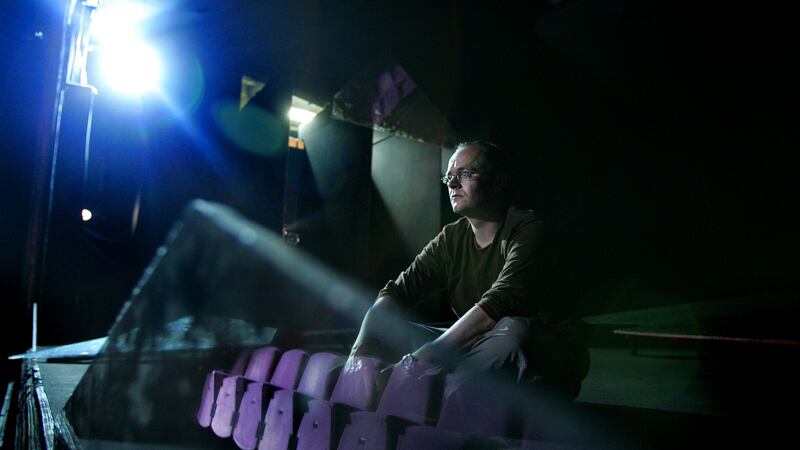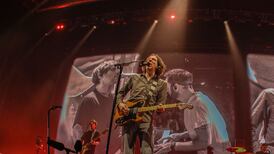In his 2007 play Terminus, Mark O’Rowe brings the audience on a whirlwind journey though Dublin city, from its inner-city core to the outer reaches of the Red Cow Roundabout and beyond. We see familiar landmarks from different perspectives: Ormond Quay from the cab of a stolen lorry; Jervis Street from the precarious height of a crane. But O’Rowe brings us on a metaphysical journey too: from purgatorial depravation to ecstatic sexual escape; from the physical space of the theatre into the limitless depths of our imaginations. Scanning the city from the heights of a ride she catches with a demon, the character of A evokes the “sullied magnificence” of the city below her, its majestic resonances and compromised beauty. It is, more than anything, this blend of base subject and artistic poetry that defines the work of Mark O’Rowe, whose first play was produced 21 years ago.
Terminus typifies the bold experiment and challenge of an O’Rowe play. A series of three overlapping monologues, it is dense with imagery and linguistic experiment. If the subject matter is drawn from a kind of comic-book fantasy, its heightened poetry and complex rhyming patterns sculpt high art from some of the most sordid impulses of human behaviour. Consider his 2003 play for women, Crestfall, where rape, abortion and bestiality feature significantly in the exploration of female sexuality. Or his most recent play, Our Few and Evil Days (2014), where a family is torn apart by a son’s incestuous impulses.
O’Rowe is best known for using first person address to engage sympathy for characters that might easily be considered vile and violent. The dual anti-heroes of Howie the Rookie (1999) seem more vulnerable than dangerous when we see the world from their perspective. The character of C in Terminus exudes charm as well as menace; as he narrates his journey we see a sensitive soul as well as a serial killer. O’Rowe’s characters are heroes in their own worlds, with their own ethical codes and journeys of revenge and honour. As hit-man Drongo in one of O’Rowe’s first plays says, right before he raises a gun to shoot a debtor, “Without moral values, ethics, etiquette, principles, we are without rules…If I don’t stick to my rules, then what am I?” (The Aspidistra Code) The criminal character of Lehiff from O’Rowe’s 2003 film Intermission expresses the complexity of this moral compass with his catchphrase “be good”.

Although O’Rowe has often been criticised for using what detractors have called a non-dramatic or easy-wipe form, O’Rowe has also experimented with more traditional forms of dramatic realism. The Aspidistra Code and From Both Hips (1997) are both one-act kitchen sink dramas, though they feature embryonic reflections of the work to come. Although conventional in form, their extreme characters and revenge plots exploded the realist frame from within. The mid-career play Made in China (2001) followed suit, while Our Few and Evil Days, still playing at the Abbey Theatre as this book went to press in a production directed by O’Rowe himself, plays with an extreme mode of naturalism.
O'Rowe does not have a preference for one form over another: it is merely a case of how a story can best be told. There is deep metaphorical resonance to his use of the monologue too. His characters are outsiders, alienated from family, friends, and often society at large. On a political level, the monologue is their opportunity to have their voices heard; on a metaphysical level it provides the "illusion of presence through voices" (Terminus), as the character of B puts it; the comfort of words spoken in the dark. And yet O'Rowe's attraction to the monologue seems significant: there is no fourth wall for the audience to hide behind. The monologue has allowed him to break down the barrier between stage and stalls, and "make the audience complicit" (Sara Keating, Mark O'Rowe: The Power to Shock – And Feel, The Irish Times, September 26th, 2014).
This complicity has not been without controversy. The sexual violence of Crestfall divided critics and audiences alike, as did Terminus, which features, among other things, a young woman copulating with a demon. On the larger dramatic canvas of Our Few and Evil Days, meanwhile, O’Rowe’s decision to make visible the dead perpetrator of incest in the play’s final moments drew audible inhalations from the audience on the several occasions that the editors of this collection saw it.
This collection balances academic appraisals of O’Rowe’s plays and films with personal testimonies from leading Irish theatre practitioners who have been instrumental in ensuring the writer’s continued success. Director Jimmy Fay’s opening essay recalls how he first encountered O’Rowe when they were in their twenties, both emerging from the “brutal landscape” that was the Dublin suburb of Tallaght in the 1970s. Fay reflects on the production of Anna’s Ankle as part of his Theatre of Cruelty Season at the Project Arts Centre in 1997 and the ensuing furore in response to the play’s graphic content. This essay traces their subsequent collaboration from their partnership on Henry IV Part 1 at the Peacock Theatre in 2002 to Fay’s direction of Howie the Rookie in 2006, with an anecdotal and witty pertinence.
Actor Aidan Kelly’s essay is an equally astute insight into his artistic relationship with O’Rowe, in particular his experience preparing for the role of The Howie Lee for the London premiere of Howie the Rookie. Approached by the writer (the “small guy with the glasses” of the essay’s title) in the Sackville Lounge in Dublin in 1998, Kelly agreed to co-star in the play at the Bush Theatre the following year. His essay thoroughly reflects on the actorial challenges posited by the play, notably its monologue form and the difficulties in pitching the Dublin vernacular for a British audience.
Thomas B Costello’s essay suitably proposes a complementary analysis of this play in terms of the dramaturgical challenges that the monologue form presents. His essay employs Brian Richardson’s writings on diegetic narration and implied authorship to offer an original reading of O’Rowe’s distinctive narrative style.
Tim Barrett also concentrates on the formal qualities of the dramatic writing, starting with O’Rowe’s lesser-known and as of yet unpublished Anna’s Ankle and uncovering how issues of performativity and class equally apply to Howie the Rookie, Crestfall and Terminus. In particular, Barrett reveals how the “illocutionary force of the monologues shapes middle-class encounters with represented worlds of brutality and abjection”.
Sara Keating’s production study of Crestfall offers an interrogatory analysis of a challenging piece of theatre for both the audience and those involved in its production. It includes testimonies by O’Rowe himself, the director Garry Hynes, set designer Francis O’Connor, actors Eileen Walsh and Aisling O’Sullivan, as well as subsequent reactions to the play in the media. Crestfall is a testimony to O’Rowe’s ability to push the boundaries of both theatrical and moral acceptability and Keating’s case study attests to its relevance and importance within the writer’s dramatic canon.
Harvey O’Brien’s essay on O’Rowe’s writing for film is an essential addition to this collection as it exposes how the writer’s authorial presence is equally evident in his original feature screenplays, adaptations and shorts, as it is in his plays. Moreover, the essays featured in this collection approach O’Rowe’s plays with new refreshing theoretical frameworks, accessing the sociological contexts of their conception and offering original readings of O’Rowe’s dramatic oeuvre in terms of both Irish and global dramatic trends.
David S Clare’s essay focuses on both the writer’s early work for theatre and his screenplay for Intermission (2003), and demonstrates how these works succeed in satirising the contemporary society that produced them by mocking the middle-class tendency to procure intercultural, non-Irish identities that usurp their own. On the other hand, Nelson Barre situates Terminus (2007) in terms of current definitions of globalisation, arguing that critical commentaries on the violence in this play ignore its reliance on “international interconnectivity”. Barre suggests a prospective redemption for the characters as they strive to transcend the isolated dramatic world of the play. Also in relation to Terminus, Marie Kelly probes the Cartesian notion of the cogito, demonstrating how the play “savagely smashes through the Cartesian mirror frame, the illusion upon which the theatre metaphor rests”. Kelly’s essay analyses how this shattering of consciousness relates to current discussions on the issue and she contextualises these arguments in relation to contemporary Irish theatre.
Emma Creedon’s essay analyses O’Rowe’s Made in China (2001) in relation to his adaptation of Henry IV Part One for the Peacock stage in 2002. She exposes the thematic similarities between the two plays in terms of “the legitimacy of ruler-ship, the shackles of inheritance and the cogency of loyalty”. She also notes the formal similarities of the writing in terms of the juxtaposition of “high” vocabulary, interspersed with “low” urban slang and how language, like masculinity, becomes performative and a vehicle for supremacy.
In her production study of O’Rowe’s most recent play, Our Few and Evil Days (2014), Emilie Pine identifies familiar tropes from O’Rowe’s earlier work, notably “men with mother issues, men who do violence (emotional or physical) to women in the name of love [and] women who put up with the violence in the name of love”. However, Pine notes that O’Rowe’s dramatisation of the “criminal and merciless side of human nature through grotesque humour and confrontation” jars with the domestic realism of the setting in an unsettling and startling manner. The play, which premiered at the Abbey Theatre in September 2014 as part of the Dublin Theatre Festival, was commissioned by the National Theatre and directed by O’Rowe himself, its production marking the debut appearance of O’Rowe’s work on the Abbey main stage.
This collection concludes with a crucial interview with the writer himself, conducted by Cormac O’Brien to coincide with the revival of Howie the Rookie at the Project Arts Centre in Dublin in 2013, as performed solely by Tom Vaughan-Lawlor. This interview offers a fascinating insight into O’Rowe’s creative processes; it exposes the literary, theatrical and filmic influences on his writing, reflects on the delicate relationship between the spectator and the monologist, and discloses his exciting plans for future projects.
This is an edited version of the introduction by Sara Keating and Emma Creedon to their The Theatre of Mark O’Rowe (Carysfort Press, Dublin, 2015)















